Memento Mori translation….. Literally “Remember to die”
At possibly no other time in history have the living been so preoccupied with the dead as in the Victorian era. It was during this period that postmortem photography (also known as memorial portraiture, mourning photography, or memento mori ) thrived. Postmortem photography, the practice of photographing the recently deceased, was, in fact, an extremely prevalent form of photography in the Victorian era; more photographs of this type were taken than of any other single type of photography for the time period.
Memorial portraits did not begin with photography, long before the invention of even the early camera obscura, paintings of the deceased occurred. The clergy of the sixteenth century were often painted immediately following death, usually sitting up, or lying, in bed. In the early nineteenth century, it was customary to paint the portraits of wealthy young children whom had died, usually illustrating the child alive, but with a symbol of some sort to indicate death.
The invention of the daguerreotype, the first commercially practical photographic process in 1839, made portraiture much more mainstream. Although the majority could not afford to commission an artist to capture their portrait, more could afford to sit for a photographic session. Although, like paintings, the daguerreotype could not be reproduced, it was much faster than sitting for a painting, requiring only 10 -15 minutes in bright lighting. The more moderate cost and time involved offered middle-class Victorians the means to memorialize their deceased relatives.
A daguerreotype was very decorative. The photo image is on a silver clad copper sheet which is attached to a sheet of glass by a foil-like brass decorative frame. These photographs offered families a cherished keepsake to remember their lost loved ones by. They served to preserve the image of the deceased in a way that had not previously been available to the majority of Victorians. Most people of that time period never had a portrait painted, or even a photograph taken, in their entire lives. Though more affordable than a commissioned painted portrait, at $5.00 for a daguerreotype, it was still more than a weeks pay for most people. In most cases, a postmortem photograph might be the only image of the deceased that the family ever had. Especially common are postmortem photographs of infants and young children. Victorian era childhood mortality rates were extremely high, and especially in the case of very young children, most families would never have had an image to remember their lost child by, were it not for these memorial portraits.
1854 saw the advancement in photography of color-tinted ambrotypes, thin negative images on glass made to appear as a positive by showing them against a black background. Ambrotypes sold at less than half the price of a daguerreotype. Tintypes, introduced in 1856 and made of thin black iron, were cheaper yet. Sold for a penny or less, tintypes made photography universally available. With a greater demand for their work, postmortem photographers began to experiment by “enhancing” the effect of life in memorial portraits; methods such as propping the subject’s eyes open, painting eyes onto the subject’s closed lids, or painting pupils onto the photographic print were utilized. A rosy tint could even be added later to the cheeks of the corpse on a tintype. Interestingly, as the costs involved with photography itself decreased, the price for a postmortem photograph actually increased, indicating its value and continued popularity.
Early postmortem photographs are usually close-ups of the face, or full-body shots, and rarely include a coffin. The subject was often depicted as if asleep, but another popular practice was to arrange the subject to appear more lifelike, including bracing or tying the corpse into a standing position, or supporting the corpse on the bodies of other family members in the portrait. Children were often shown lying on a couch or in a bed, often with a favorite toy. It was common to photograph very young children with a family member, frequently the mother, but often with older siblings. Adults were more commonly posed in chairs or even braced and tied onto specially-designed frames.
By 1859, a new photographic process, producing the carte de visite or CDV had become widespread. The CDV was a small photograph, usually made of an albumen print -a thin paper photograph mounted on a thicker paper card. With a CDV, multiple prints could be made from a single negative; this meant that copies of the postmortem photograph could be mailed to relatives. Surviving families were proud of these images; hanging them in their homes, sending copies to friends and relatives (who may have never seen the deceased before the death), wearing them as lockets, or carrying them as pocket mirrors.
By the early 1870s, cartes de visite were completely overthrown by “cabinet cards,” which were also usually albumen prints, but larger, mounted on cardboard backs measuring 4½ by 6½ inches.
The official practice of postmortem photography began to fade in the early twentieth century. Kodak introduced the Brownie camera and “snapshot” photography became a mass phenomenon; photos became more commonplace, and viewed much less as works of art. Death also became sparser, as health care and medical knowledge gained ground. Rather than embracing mortality, society began to shun any reminders of it. Up until this time, most funerals had taken place at home, in the parlor, or “death room”. As more and more funerals began to take place in the new funeral parlors, the home parlor became known as the “living room”, and in 1910, the Ladies Home Journal declared the “death room” to be a term of the past.
For further examples of Victorian postmortem photography:
http://www.flickr.com/photos/misty_bee/sets/72157626699396884/

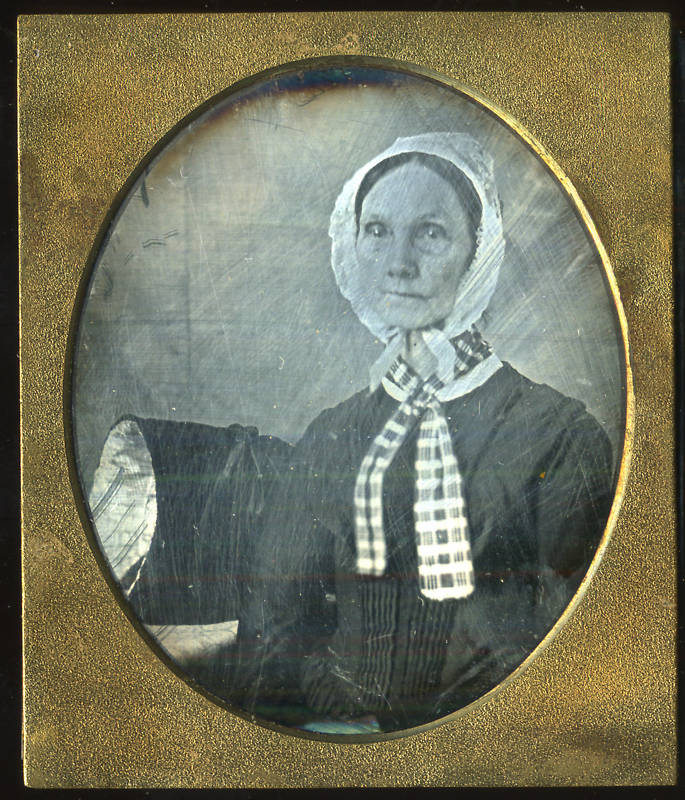

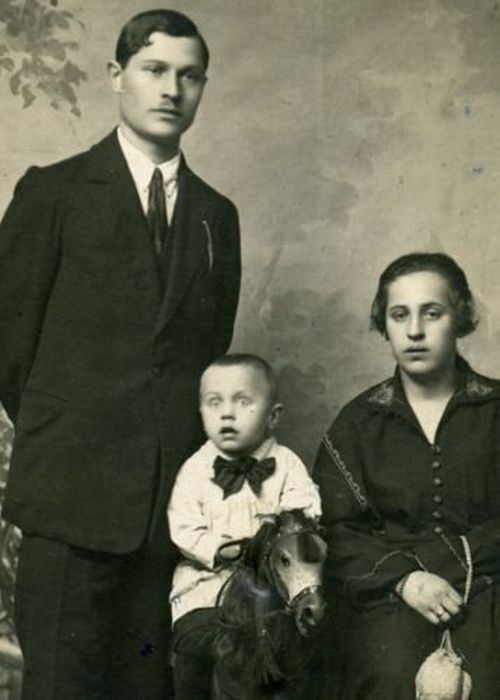
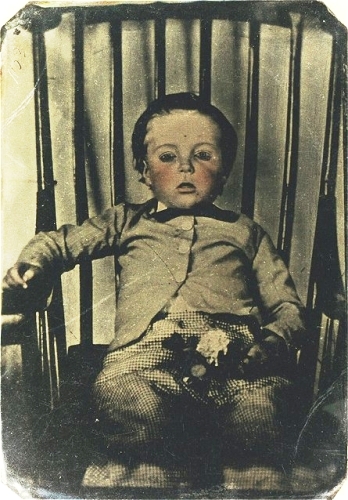
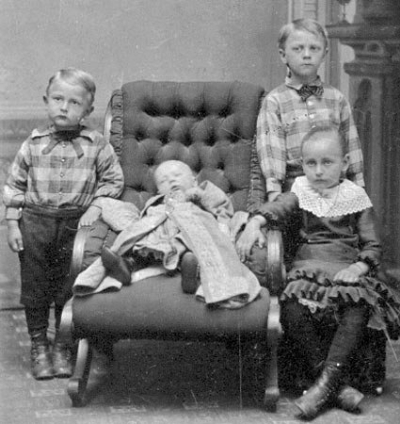
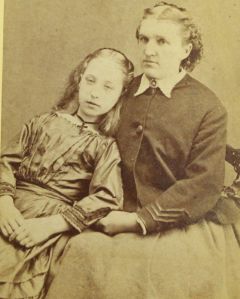
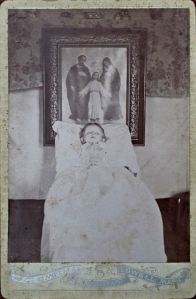
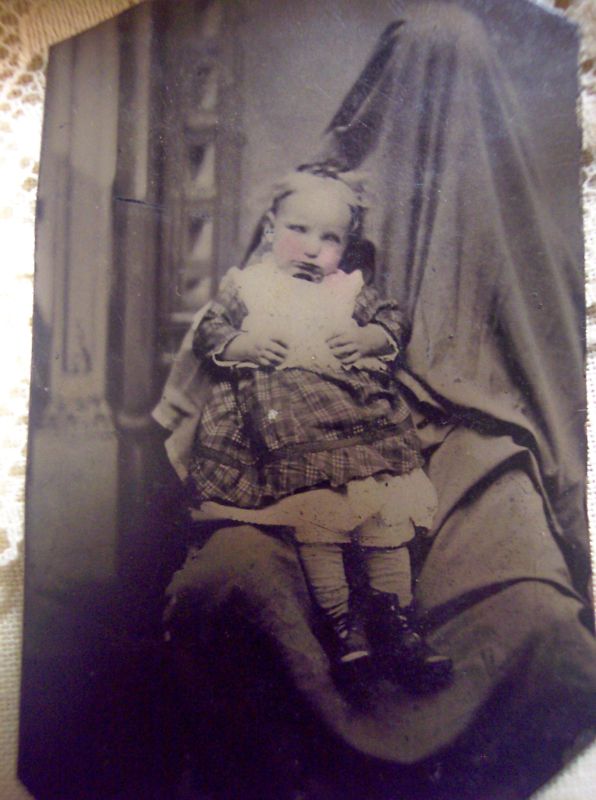
I was looking for something completely different for my dissertation, but have found myself drawn to this. Really good web page on a topic I did not know existed.
Thank you; it’s fascinating, isn’t it?
Amazing! Scary.
i was amazed!!
How can you tell who is dead in the photos? what are the clues? I’m thinking of the family photo with the parents with the child on a rocking(?) horse. I cn’t tell who is dead. thanks.
In the case of that particular photo, the child on the rocking horse is the deceased. Often you can recognize a postmortem photo by looking for certain signs: magnification of the face to look for fixed, dilated pupils, or “painted on” pupils, fixed expressions, mouths held closed artificially, signs of a stand if the person is standing, or a neck brace if the person is sitting, and occasionally, photography studio information on the back will actually tell you if the photographer specialized in memorial portraiture.There is an extremely in-depth book preview at the following link that goes into great detail on the “tricks-of-the-trade” that photographers of the era used to try to convey a life-like image.
http://www.scribd.com/doc/88228949/Likeness-Early-Postmortem-Photography-and-the-Pornography-of-Death
You can tell who is dead in earlier memento mori photos by looking at the eyes. Since they’ll normally have their eyes propped open, the picture resolution will blur the eyes of the living because they blinked. They could also have less color to them or be less blurred in general than other objects or people in the photo.
I enjoyed your presentation on the subject of Victorian Mourning Pictures. I was lucky enough to have taken an elective college English course which delved in-depth into the psychology and purpose of these heart-wrenching photographs.
I think our class concluded that the main reason for this period in photography was the fact that the art of photography was still in its infancy and was still unaffordable for the majority of the people. However, when someone died in a family and the person who died had never been photographed before, the survivors were usually willing to pay any cost just to have a final memento of that person as they once lived.
This is a very heartbreaking subject. I don’t know if you have heard about the following painting, but it has a very interesting story to go with it. In fact, as you read more about it, I think there is a poem by Adrienne Rich that was written years later to accompany the painting:
http://en.wikipedia.org/wiki/Edwin_Romanzo_Elmer
http://templepoetry.blogspot.com/2009/06/mourning-picture.html
In the dauguerrotype, which required the subjects to be completely still for several minutes, the parents have moved slightly blurring their images, while the dead girl, being dead, has not moved and is crystal clear in the picture.
I do not even know how I ended up here, but I thought this
post was great. I do not know who you are but definitely you are going to a famous blogger if you are not already 😉 Cheers!
Pingback: Haunting mystery girl, part 1 | BlackenedRoots.com
I have 2 quite large postmortem paintings of babies that I just bought recently. I can’t find any info on these or what they would be worth. I am wondering if they are rare. Both antique stores didn’t have a clue what the were but I did right away. Just wondering if anyone has any info on postmortem paintings! Please email me if so! Blondebabe0028@bellsouth.net thanks!!
Pingback: A vikoriánus Anglia post-mortem fotói | GRJ
Thank you,
I was looking at a photo on eBay and thought it might be of this type.
I was trying to explain to my son why people did this.
Fascinating
Jules
Особенности фото викторианской эпохи – т!!!!!!!!!!!!!!!!!!!!!!!!!!
Ент правда в те времена немного другие были условия, все таки многое потом пришло, ни че норм, напрмиер в Волагсогаред и сейчас могут вам зделать фотки в Ритуальном бюро такие и видеозаписи, что пакойник делають – т так, что видеоизображением из гроба встаеть – т, ходит по залу, опять ложиться, или есче как он работает напрмиер, при чем сымают и показывають – т на похоронах, перд всеми родствениками и друзьями, в пращальном зале, потом покойного переносят в авто-Катафалк и первозят к месту захоронения, ент тож такое в Волагсоагред делают, там картины из жизни крутят. Если учитывать, тот факт, что в Цакрицыне вообще до революции, производили закопку могил, только после того, как их набереться в траншеии не менее 10 – 15 гробов, их просто прикрывали досками,ж учитывая Волагсррадскую жару, то там полная антисанитария была +50 градусов, мух не меренно разлеталась по городу, богатых – сразу закапывали, а бедных по мере накопления. Катафалк в Дореволюционом Царицыне стоил 800 рублей похороны, производились навреное и фотографии. В принцыпе сейчас производяться свободно, только оплата клиента, там всякие и сейчас делають – т. Вообще современный Волгаосрд, енто сочетание средневековья и ХХ1 века, так, что для жителя Волагсрадла, иде все рядом такие фотографии в полне приемлемы. Говорю в волгроасде с помощью видеосъемке во время похорон оживляют усопшего, ну он как бы в проекции, ходит, работает, конечно усопший лежит рядом, но вкарции его жизнь рассказывають – т и показывають – т на проекторе на похоронах и енто в нашем городе стандартное явление, обычно для нашего города. Так что почему вы так испугались не понятно, ведь у нас енто не вызвало бы ни какого шока, етно обыденость для нашего города. Ну в проекции на стене делають – т как человек ходит, его голос звучит, как он работаеть – т там, все такое прямо на похоронах, там ну родствиникам показывають – т рассказывають – т, енто в полне нормально и обычно и все адыкватно реагирують – т, что вы такие слабонервные, вот и представте усобший в гробу лежит, рядом на стене егоизображение ходит. работает, во весь голос говорит, можт и енто для вас может вызвать удевление, но для Волагсорраде етно обычные похороны и ни какого шока не у кого не вызываеть – т, даж все рады и благодарны, все таки вы страные каке то!!!!!!!!!!!!!!!!!!!!!!!!!!!!!
Pingback: Synesthesia Garden - a weird art + style blog | » Blog Archive » The Abandoned Child: Necronymphic Creations by Tari Nakagawa
I came across this page while doing research for a term paper for CDVs. I loved it.
I think the photo of the dead young woman sitting between her mother and father is printed back to front. The buttoning of the fathers clothes in particular is on the wrong side. It should be left over right..The dead young girl’s clothes should be right side of dress folded over left side. The mother should be showing a wedding ring on her left hand but when reversed, it is her right hand which is shown and hence no ring..
Because Daguerreotypes produced a single finished image, not a negative, the picture is a mirror-image
Daguerreotype photography produced a single positive image, rather than negatives that could produce multiple positive images. So every Daguerreotype is a mirror image of the scene captured.
Pingback: The Abandoned Child: Necronymphic Creations by Tari Nakagawa | Necromantic
I just found one of these in my grandfathers closet and researched it and this was so fascinating. I have it on me now of a stately man in a mirror image and it has a detailed leather case with a hook that clasps it shut. I just don’t know who this man is…
Reblogged this on Teen Help .